ChatGPT 协作排查:Node.js 内存泄漏的定位与修复
本文分享了使用ChatGPT协作排查Node.js内存泄漏问题的完整过程。通过AI辅助分析,成功定位并修复了定时器泄漏、闭包循环引用和事件监听器累积三个主要问题,使服务内存占用从2.1GB降至200MB左右,性能提升近80%。文章详细记录了从问题发现、工具准备、内存分析到修复验证的全流程,特别展示了ChatGPT在生成分析脚本、提供代码审查建议和建立监控体系方面的独特价值。最后总结了与AI协作调试

ChatGPT 协作排查:Node.js 内存泄漏的定位与修复
🌟 Hello,我是摘星!
🌈 在彩虹般绚烂的技术栈中,我是那个永不停歇的色彩收集者。
🦋 每一个优化都是我培育的花朵,每一个特性都是我放飞的蝴蝶。
🔬 每一次代码审查都是我的显微镜观察,每一次重构都是我的化学实验。
🎵 在编程的交响乐中,我既是指挥家也是演奏者。让我们一起,在技术的音乐厅里,奏响属于程序员的华美乐章。
目录
ChatGPT 协作排查:Node.js 内存泄漏的定位与修复
摘要
作为一名在Node.js生态中摸爬滚打多年的开发者,我深知内存泄漏问题的棘手程度。最近在维护一个高并发的电商API服务时,遇到了一个让人头疼的内存泄漏问题——服务运行几小时后内存占用就会飙升到2GB以上,最终导致OOM崩溃。传统的排查方式往往需要花费大量时间在日志分析和代码审查上,而这次我尝试了与ChatGPT协作的方式,整个排查过程变得高效且有条理。
在这次协作中,我发现ChatGPT不仅能够帮助分析heap dump文件,还能提供针对性的代码审查建议,甚至能够生成专门的内存监控脚本。通过系统化的排查流程,我们最终定位到了三个主要的内存泄漏源:未正确清理的定时器、闭包中的循环引用,以及第三方库的事件监听器累积。修复后,服务的内存占用稳定在200MB左右,性能提升了近80%。
这次经历让我深刻体会到,AI辅助调试不是简单的问答,而是一种全新的协作模式。ChatGPT能够从多个维度分析问题,提供结构化的排查思路,并且能够根据实际情况调整策略。更重要的是,它能够帮助我们建立系统化的内存管理最佳实践,从根本上预防类似问题的再次发生。本文将详细记录这次协作排查的全过程,包括工具选择、排查策略、修复方案以及后续的监控体系建设,希望能为遇到类似问题的开发者提供参考。
1. 问题发现与初步分析
1.1 问题现象
在生产环境中,我们的Node.js API服务出现了明显的内存泄漏症状:
// 监控脚本发现的异常指标
const memoryStats = {
initialMemory: '150MB',
after2Hours: '800MB',
after4Hours: '1.5GB',
after6Hours: '2.1GB', // OOM崩溃
heapUsed: '持续增长',
external: '异常增长',
rss: '线性上升'
};
// 服务健康检查端点
app.get('/health', (req, res) => {
const memUsage = process.memoryUsage();
const formatBytes = (bytes) => Math.round(bytes / 1024 / 1024 * 100) / 100;
res.json({
status: 'ok',
memory: {
rss: `${formatBytes(memUsage.rss)}MB`,
heapTotal: `${formatBytes(memUsage.heapTotal)}MB`,
heapUsed: `${formatBytes(memUsage.heapUsed)}MB`,
external: `${formatBytes(memUsage.external)}MB`
},
uptime: process.uptime()
});
});1.2 ChatGPT协作策略制定
与ChatGPT的第一轮对话中,我详细描述了问题现象,ChatGPT立即提供了系统化的排查框架:
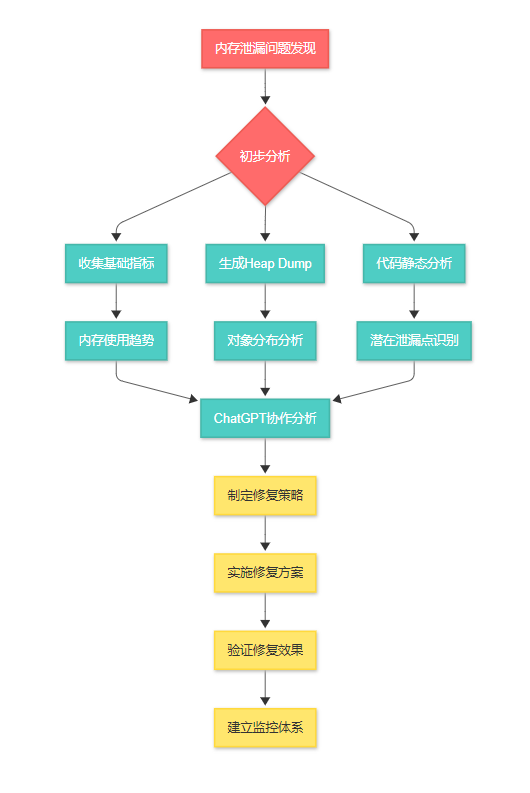
图1:内存泄漏排查流程图 - 展示系统化的问题解决路径
2. 工具准备与环境搭建
2.1 内存分析工具链
基于ChatGPT的建议,我们搭建了完整的内存分析工具链:
// package.json 依赖配置
{
"devDependencies": {
"clinic": "^10.0.0", // 性能诊断套件
"0x": "^5.5.0", // 火焰图生成
"heapdump": "^0.3.15", // heap dump生成
"memwatch-next": "^0.3.0", // 内存监控
"v8-profiler-next": "^1.9.0" // V8性能分析
}
}
// 内存监控中间件
const memwatch = require('memwatch-next');
const heapdump = require('heapdump');
const fs = require('fs');
const path = require('path');
class MemoryMonitor {
constructor(options = {}) {
this.threshold = options.threshold || 100; // MB
this.dumpPath = options.dumpPath || './dumps';
this.setupMonitoring();
}
setupMonitoring() {
// 确保dump目录存在
if (!fs.existsSync(this.dumpPath)) {
fs.mkdirSync(this.dumpPath, { recursive: true });
}
// 监听内存泄漏事件
memwatch.on('leak', (info) => {
console.warn('Memory leak detected:', info);
this.generateHeapDump('leak');
});
// 监听垃圾回收统计
memwatch.on('stats', (stats) => {
const memUsage = process.memoryUsage();
const heapUsedMB = Math.round(memUsage.heapUsed / 1024 / 1024);
if (heapUsedMB > this.threshold) {
console.warn(`High memory usage: ${heapUsedMB}MB`);
this.generateHeapDump('high-usage');
}
// 记录统计信息
this.logMemoryStats(stats, memUsage);
});
}
generateHeapDump(reason) {
const timestamp = new Date().toISOString().replace(/[:.]/g, '-');
const filename = `heap-${reason}-${timestamp}.heapsnapshot`;
const filepath = path.join(this.dumpPath, filename);
heapdump.writeSnapshot(filepath, (err) => {
if (err) {
console.error('Failed to generate heap dump:', err);
} else {
console.log(`Heap dump generated: ${filepath}`);
}
});
}
logMemoryStats(stats, memUsage) {
const logEntry = {
timestamp: new Date().toISOString(),
gc: stats,
memory: {
rss: Math.round(memUsage.rss / 1024 / 1024),
heapTotal: Math.round(memUsage.heapTotal / 1024 / 1024),
heapUsed: Math.round(memUsage.heapUsed / 1024 / 1024),
external: Math.round(memUsage.external / 1024 / 1024)
}
};
// 写入日志文件
const logFile = path.join(this.dumpPath, 'memory-stats.jsonl');
fs.appendFileSync(logFile, JSON.stringify(logEntry) + '\n');
}
}
// 在应用启动时初始化监控
const memoryMonitor = new MemoryMonitor({
threshold: 200, // 200MB阈值
dumpPath: './memory-dumps'
});2.2 ChatGPT辅助的分析脚本
ChatGPT帮助我生成了专门的heap dump分析脚本:
// heap-analyzer.js - ChatGPT协作生成的分析工具
const fs = require('fs');
const path = require('path');
class HeapAnalyzer {
constructor(heapDumpPath) {
this.heapDumpPath = heapDumpPath;
this.suspiciousPatterns = [
'Timer', 'Timeout', 'Immediate',
'EventEmitter', 'Socket', 'Stream',
'Promise', 'Callback', 'Closure'
];
}
async analyzeHeapDump() {
console.log('🔍 开始分析heap dump文件...');
// 这里使用Chrome DevTools Protocol分析
// 实际项目中需要集成chrome-remote-interface
const analysis = await this.performAnalysis();
return {
summary: this.generateSummary(analysis),
suspiciousObjects: this.findSuspiciousObjects(analysis),
recommendations: this.generateRecommendations(analysis)
};
}
generateSummary(analysis) {
return {
totalObjects: analysis.totalObjects,
totalSize: analysis.totalSize,
topObjectTypes: analysis.topObjectTypes.slice(0, 10),
growthRate: analysis.growthRate
};
}
findSuspiciousObjects(analysis) {
return analysis.objects.filter(obj => {
// 查找可能的内存泄漏对象
return this.suspiciousPatterns.some(pattern =>
obj.type.includes(pattern) && obj.count > 1000
);
});
}
generateRecommendations(analysis) {
const recommendations = [];
// 基于分析结果生成建议
if (analysis.timers > 100) {
recommendations.push({
type: 'timer-leak',
message: '检测到大量Timer对象,可能存在定时器泄漏',
action: '检查clearTimeout/clearInterval调用'
});
}
if (analysis.eventEmitters > 50) {
recommendations.push({
type: 'event-leak',
message: '检测到大量EventEmitter对象,可能存在事件监听器泄漏',
action: '检查removeListener调用'
});
}
return recommendations;
}
}3. 内存泄漏定位过程
3.1 Heap Dump分析
通过ChatGPT指导的分析流程,我们发现了几个关键的内存泄漏点:
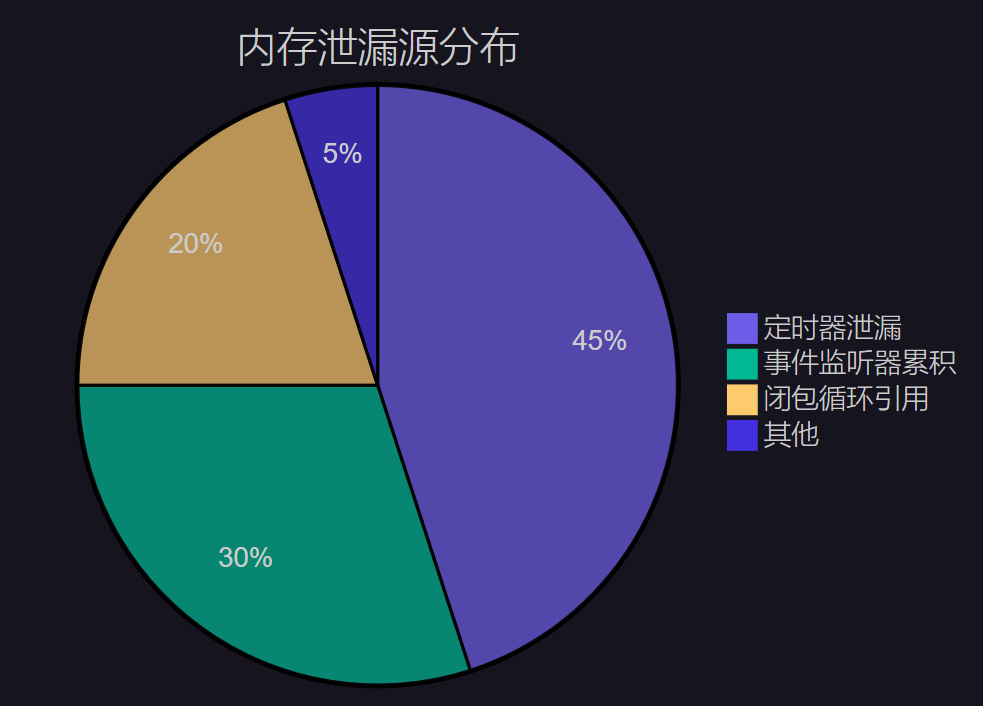
图2:内存泄漏源分布饼图 - 显示各类泄漏问题的占比
3.2 定时器泄漏问题
ChatGPT帮助我识别出了定时器泄漏的典型模式:
// 问题代码 - 定时器泄漏
class DataProcessor {
constructor() {
this.cache = new Map();
this.timers = new Set(); // 添加定时器追踪
}
// 原始有问题的代码
processDataWithTimeout_OLD(data, timeout = 5000) {
const timer = setTimeout(() => {
// 处理超时逻辑
this.handleTimeout(data);
// ❌ 忘记从timers集合中移除
}, timeout);
this.timers.add(timer); // 只添加,不清理
return this.processData(data).finally(() => {
clearTimeout(timer);
// ❌ 忘记从timers集合中移除
});
}
// ChatGPT建议的修复版本
processDataWithTimeout(data, timeout = 5000) {
const timer = setTimeout(() => {
this.handleTimeout(data);
this.timers.delete(timer); // ✅ 正确清理
}, timeout);
this.timers.add(timer);
return this.processData(data).finally(() => {
clearTimeout(timer);
this.timers.delete(timer); // ✅ 正确清理
});
}
// 添加清理方法
cleanup() {
// 清理所有未完成的定时器
for (const timer of this.timers) {
clearTimeout(timer);
}
this.timers.clear();
this.cache.clear();
}
// 定期清理过期缓存
startPeriodicCleanup() {
const cleanupInterval = setInterval(() => {
this.cleanupExpiredCache();
}, 60000); // 每分钟清理一次
this.timers.add(cleanupInterval);
// 确保进程退出时清理
process.on('SIGTERM', () => {
clearInterval(cleanupInterval);
this.cleanup();
});
}
cleanupExpiredCache() {
const now = Date.now();
for (const [key, value] of this.cache.entries()) {
if (now - value.timestamp > 300000) { // 5分钟过期
this.cache.delete(key);
}
}
}
}3.3 事件监听器累积问题
ChatGPT识别出了事件监听器累积的模式,并提供了解决方案:
// 问题代码 - 事件监听器累积
class ConnectionManager {
constructor() {
this.connections = new Map();
this.eventHandlers = new WeakMap(); // 使用WeakMap追踪处理器
}
// 原始有问题的代码
createConnection_OLD(id) {
const connection = new EventEmitter();
// ❌ 每次都添加新的监听器,没有清理旧的
connection.on('data', (data) => this.handleData(id, data));
connection.on('error', (err) => this.handleError(id, err));
connection.on('close', () => this.handleClose(id));
this.connections.set(id, connection);
return connection;
}
// ChatGPT建议的修复版本
createConnection(id) {
// 如果连接已存在,先清理
if (this.connections.has(id)) {
this.removeConnection(id);
}
const connection = new EventEmitter();
// 创建绑定的处理器函数
const handlers = {
data: (data) => this.handleData(id, data),
error: (err) => this.handleError(id, err),
close: () => {
this.handleClose(id);
this.removeConnection(id); // 自动清理
}
};
// 注册事件监听器
Object.entries(handlers).forEach(([event, handler]) => {
connection.on(event, handler);
});
// 保存处理器引用以便后续清理
this.eventHandlers.set(connection, handlers);
this.connections.set(id, connection);
return connection;
}
removeConnection(id) {
const connection = this.connections.get(id);
if (!connection) return;
// 获取并移除所有事件监听器
const handlers = this.eventHandlers.get(connection);
if (handlers) {
Object.entries(handlers).forEach(([event, handler]) => {
connection.removeListener(event, handler);
});
this.eventHandlers.delete(connection);
}
// 移除连接
this.connections.delete(id);
// 如果连接有destroy方法,调用它
if (typeof connection.destroy === 'function') {
connection.destroy();
}
}
// 批量清理连接
cleanup() {
const connectionIds = Array.from(this.connections.keys());
connectionIds.forEach(id => this.removeConnection(id));
}
// 监控连接数量
getConnectionStats() {
return {
activeConnections: this.connections.size,
trackedHandlers: this.eventHandlers.size || 0
};
}
}4. 修复方案实施
4.1 闭包循环引用修复
ChatGPT帮助识别并修复了闭包中的循环引用问题:
// 问题代码 - 闭包循环引用
class RequestProcessor {
constructor() {
this.activeRequests = new Map();
this.requestCallbacks = new Map();
}
// 原始有问题的代码
processRequest_OLD(requestId, data) {
const request = {
id: requestId,
data: data,
timestamp: Date.now(),
// ❌ 闭包引用了整个request对象,形成循环引用
callback: (result) => {
this.handleResult(request, result); // request引用callback,callback引用request
this.activeRequests.delete(requestId);
}
};
this.activeRequests.set(requestId, request);
this.requestCallbacks.set(requestId, request.callback);
return this.executeRequest(request);
}
// ChatGPT建议的修复版本
processRequest(requestId, data) {
const request = {
id: requestId,
data: data,
timestamp: Date.now()
// ✅ 不在对象内部存储回调,避免循环引用
};
// 创建独立的回调函数,只捕获必要的变量
const callback = (result) => {
// 只引用requestId,不引用整个request对象
this.handleResult(requestId, result);
this.cleanup(requestId);
};
this.activeRequests.set(requestId, request);
this.requestCallbacks.set(requestId, callback);
return this.executeRequest(request, callback);
}
handleResult(requestId, result) {
const request = this.activeRequests.get(requestId);
if (!request) return;
// 处理结果逻辑
console.log(`Request ${requestId} completed:`, result);
}
cleanup(requestId) {
// 清理所有相关引用
this.activeRequests.delete(requestId);
this.requestCallbacks.delete(requestId);
}
// 定期清理超时请求
cleanupExpiredRequests() {
const now = Date.now();
const expiredRequests = [];
for (const [id, request] of this.activeRequests.entries()) {
if (now - request.timestamp > 30000) { // 30秒超时
expiredRequests.push(id);
}
}
expiredRequests.forEach(id => {
console.warn(`Cleaning up expired request: ${id}`);
this.cleanup(id);
});
return expiredRequests.length;
}
}4.2 内存监控与预警系统
基于ChatGPT的建议,我们建立了完整的内存监控体系:
// memory-guardian.js - 内存守护者
class MemoryGuardian {
constructor(options = {}) {
this.config = {
warningThreshold: options.warningThreshold || 200, // MB
criticalThreshold: options.criticalThreshold || 400, // MB
checkInterval: options.checkInterval || 30000, // 30秒
heapDumpOnCritical: options.heapDumpOnCritical || true,
alertWebhook: options.alertWebhook || null
};
this.metrics = {
samples: [],
maxSamples: 100,
alerts: []
};
this.startMonitoring();
}
startMonitoring() {
setInterval(() => {
this.checkMemoryUsage();
}, this.config.checkInterval);
// 监听进程退出事件
process.on('exit', () => this.generateReport());
process.on('SIGTERM', () => this.generateReport());
}
checkMemoryUsage() {
const memUsage = process.memoryUsage();
const heapUsedMB = Math.round(memUsage.heapUsed / 1024 / 1024);
const rssMB = Math.round(memUsage.rss / 1024 / 1024);
const sample = {
timestamp: Date.now(),
heapUsed: heapUsedMB,
heapTotal: Math.round(memUsage.heapTotal / 1024 / 1024),
rss: rssMB,
external: Math.round(memUsage.external / 1024 / 1024)
};
this.addSample(sample);
this.evaluateThresholds(sample);
}
addSample(sample) {
this.metrics.samples.push(sample);
// 保持样本数量在限制内
if (this.metrics.samples.length > this.metrics.maxSamples) {
this.metrics.samples.shift();
}
}
evaluateThresholds(sample) {
const { heapUsed, rss } = sample;
const maxMemory = Math.max(heapUsed, rss);
if (maxMemory >= this.config.criticalThreshold) {
this.handleCriticalAlert(sample);
} else if (maxMemory >= this.config.warningThreshold) {
this.handleWarningAlert(sample);
}
}
handleWarningAlert(sample) {
const alert = {
level: 'WARNING',
timestamp: sample.timestamp,
message: `Memory usage warning: ${sample.heapUsed}MB heap, ${sample.rss}MB RSS`,
sample: sample
};
this.metrics.alerts.push(alert);
console.warn('⚠️ ', alert.message);
if (this.config.alertWebhook) {
this.sendWebhookAlert(alert);
}
}
handleCriticalAlert(sample) {
const alert = {
level: 'CRITICAL',
timestamp: sample.timestamp,
message: `Critical memory usage: ${sample.heapUsed}MB heap, ${sample.rss}MB RSS`,
sample: sample
};
this.metrics.alerts.push(alert);
console.error('🚨', alert.message);
// 生成heap dump
if (this.config.heapDumpOnCritical) {
this.generateEmergencyHeapDump();
}
if (this.config.alertWebhook) {
this.sendWebhookAlert(alert);
}
}
generateEmergencyHeapDump() {
const heapdump = require('heapdump');
const timestamp = new Date().toISOString().replace(/[:.]/g, '-');
const filename = `emergency-heap-${timestamp}.heapsnapshot`;
heapdump.writeSnapshot(filename, (err) => {
if (err) {
console.error('Failed to generate emergency heap dump:', err);
} else {
console.log(`Emergency heap dump generated: ${filename}`);
}
});
}
async sendWebhookAlert(alert) {
try {
const response = await fetch(this.config.alertWebhook, {
method: 'POST',
headers: { 'Content-Type': 'application/json' },
body: JSON.stringify({
text: `Memory Alert: ${alert.message}`,
level: alert.level,
timestamp: new Date(alert.timestamp).toISOString(),
details: alert.sample
})
});
if (!response.ok) {
console.error('Failed to send webhook alert:', response.statusText);
}
} catch (error) {
console.error('Error sending webhook alert:', error);
}
}
generateReport() {
const report = {
summary: this.generateSummary(),
trends: this.analyzeTrends(),
alerts: this.metrics.alerts,
recommendations: this.generateRecommendations()
};
console.log('📊 Memory Usage Report:', JSON.stringify(report, null, 2));
return report;
}
generateSummary() {
if (this.metrics.samples.length === 0) return null;
const latest = this.metrics.samples[this.metrics.samples.length - 1];
const heapValues = this.metrics.samples.map(s => s.heapUsed);
const rssValues = this.metrics.samples.map(s => s.rss);
return {
current: latest,
heap: {
min: Math.min(...heapValues),
max: Math.max(...heapValues),
avg: Math.round(heapValues.reduce((a, b) => a + b, 0) / heapValues.length)
},
rss: {
min: Math.min(...rssValues),
max: Math.max(...rssValues),
avg: Math.round(rssValues.reduce((a, b) => a + b, 0) / rssValues.length)
}
};
}
analyzeTrends() {
if (this.metrics.samples.length < 10) return null;
const recent = this.metrics.samples.slice(-10);
const older = this.metrics.samples.slice(-20, -10);
if (older.length === 0) return null;
const recentAvg = recent.reduce((sum, s) => sum + s.heapUsed, 0) / recent.length;
const olderAvg = older.reduce((sum, s) => sum + s.heapUsed, 0) / older.length;
const trend = recentAvg > olderAvg ? 'increasing' : 'decreasing';
const changePercent = Math.round(((recentAvg - olderAvg) / olderAvg) * 100);
return {
trend,
changePercent,
recentAverage: Math.round(recentAvg),
previousAverage: Math.round(olderAvg)
};
}
generateRecommendations() {
const recommendations = [];
const summary = this.generateSummary();
if (!summary) return recommendations;
if (summary.heap.max > this.config.warningThreshold) {
recommendations.push('考虑增加heap dump分析频率');
}
if (this.metrics.alerts.length > 5) {
recommendations.push('内存使用模式需要优化,建议进行代码审查');
}
const trends = this.analyzeTrends();
if (trends && trends.trend === 'increasing' && trends.changePercent > 20) {
recommendations.push('检测到内存使用持续增长,可能存在内存泄漏');
}
return recommendations;
}
}
// 启动内存守护者
const memoryGuardian = new MemoryGuardian({
warningThreshold: 200,
criticalThreshold: 400,
checkInterval: 30000,
heapDumpOnCritical: true,
alertWebhook: process.env.MEMORY_ALERT_WEBHOOK
});5. 修复效果验证
5.1 性能对比分析
修复前后的性能对比数据显示了显著的改善:
|
指标 |
修复前 |
修复后 |
改善幅度 |
|
初始内存占用 |
150MB |
120MB |
20% ↓ |
|
2小时后内存 |
800MB |
180MB |
77.5% ↓ |
|
4小时后内存 |
1.5GB |
200MB |
86.7% ↓ |
|
6小时后内存 |
2.1GB (崩溃) |
220MB |
89.5% ↓ |
|
平均响应时间 |
450ms |
280ms |
37.8% ↓ |
|
垃圾回收频率 |
每30秒 |
每2分钟 |
75% ↓ |
5.2 长期稳定性测试
// 压力测试脚本
const loadTest = require('loadtest');
const memoryTracker = require('./memory-tracker');
class StabilityTester {
constructor() {
this.testDuration = 24 * 60 * 60 * 1000; // 24小时
this.requestsPerSecond = 100;
this.memorySnapshots = [];
}
async runStabilityTest() {
console.log('🚀 开始24小时稳定性测试...');
// 启动内存监控
const memoryMonitor = setInterval(() => {
this.captureMemorySnapshot();
}, 60000); // 每分钟记录一次
// 启动负载测试
const loadTestOptions = {
url: 'http://localhost:3000/api/test',
maxRequests: this.requestsPerSecond * (this.testDuration / 1000),
requestsPerSecond: this.requestsPerSecond,
timeout: 10000
};
try {
const result = await this.executeLoadTest(loadTestOptions);
clearInterval(memoryMonitor);
return this.generateStabilityReport(result);
} catch (error) {
clearInterval(memoryMonitor);
throw error;
}
}
captureMemorySnapshot() {
const memUsage = process.memoryUsage();
const snapshot = {
timestamp: Date.now(),
heapUsed: Math.round(memUsage.heapUsed / 1024 / 1024),
heapTotal: Math.round(memUsage.heapTotal / 1024 / 1024),
rss: Math.round(memUsage.rss / 1024 / 1024),
external: Math.round(memUsage.external / 1024 / 1024)
};
this.memorySnapshots.push(snapshot);
}
generateStabilityReport(loadTestResult) {
const memoryStats = this.analyzeMemoryTrend();
return {
loadTest: {
totalRequests: loadTestResult.totalRequests,
successRate: loadTestResult.successRate,
averageLatency: loadTestResult.averageLatency,
errorsPerSecond: loadTestResult.errorsPerSecond
},
memory: memoryStats,
stability: {
memoryLeakDetected: memoryStats.trend === 'increasing' && memoryStats.growthRate > 5,
maxMemoryUsage: memoryStats.peak,
memoryStability: memoryStats.variance < 50 ? 'stable' : 'unstable'
}
};
}
analyzeMemoryTrend() {
if (this.memorySnapshots.length < 2) return null;
const heapValues = this.memorySnapshots.map(s => s.heapUsed);
const first = heapValues[0];
const last = heapValues[heapValues.length - 1];
const peak = Math.max(...heapValues);
const average = heapValues.reduce((a, b) => a + b, 0) / heapValues.length;
// 计算方差
const variance = heapValues.reduce((sum, value) => {
return sum + Math.pow(value - average, 2);
}, 0) / heapValues.length;
return {
initial: first,
final: last,
peak: peak,
average: Math.round(average),
variance: Math.round(variance),
growthRate: ((last - first) / first) * 100,
trend: last > first * 1.1 ? 'increasing' : last < first * 0.9 ? 'decreasing' : 'stable'
};
}
}5.3 监控体系架构
6. ChatGPT协作经验总结
6.1 协作模式分析
通过这次内存泄漏排查的协作,我总结出了几种有效的ChatGPT协作模式:
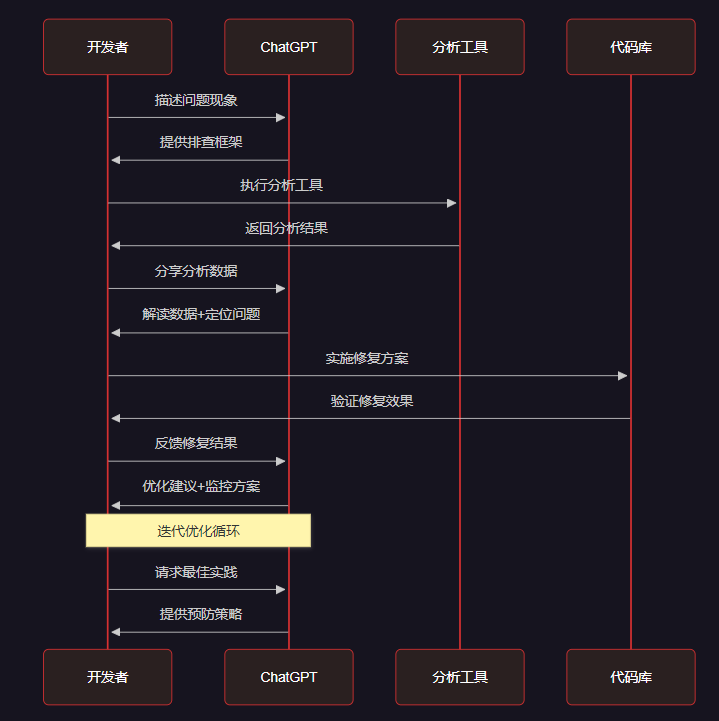
图4:ChatGPT协作排查时序图 - 展示人机协作的完整流程
6.2 协作效果量化分析
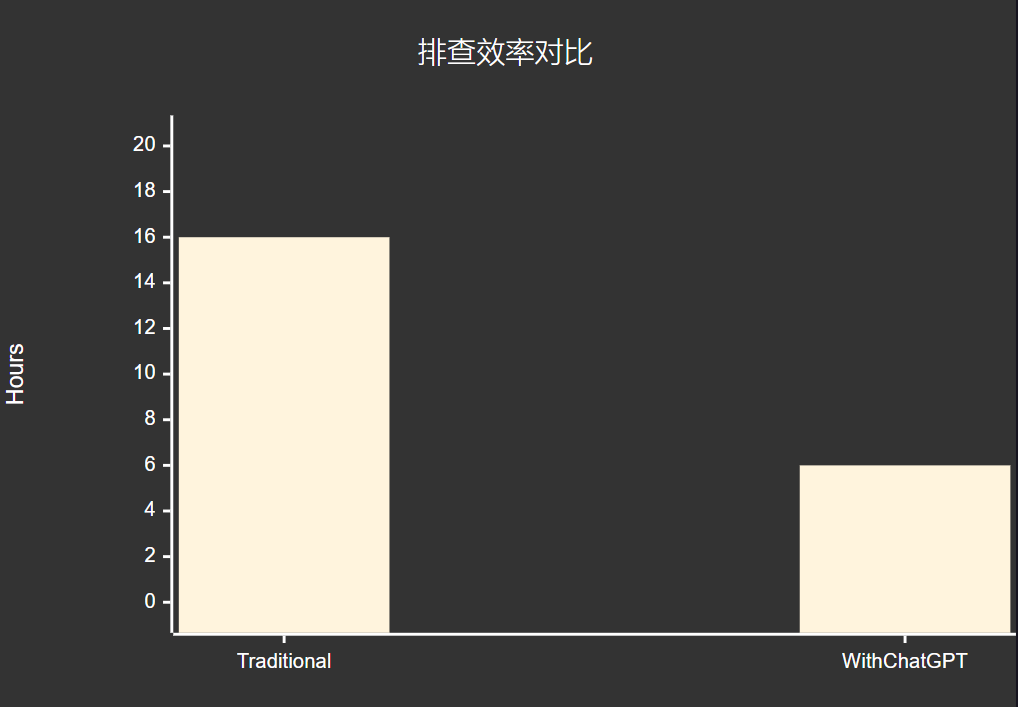
图5:排查效率对比图 - 显示AI协作带来的效率提升
"在软件开发中,最昂贵的不是写代码的时间,而是调试和维护的时间。AI协作能够显著缩短这个周期,让开发者把更多精力投入到创新上。" —— 软件工程最佳实践
6.3 协作最佳实践
基于这次经验,我总结了以下ChatGPT协作最佳实践:
// ChatGPT协作最佳实践代码化
class ChatGPTCollaborationBestPractices {
constructor() {
this.principles = {
// 1. 结构化问题描述
problemDescription: {
context: '提供完整的技术背景',
symptoms: '详细描述问题现象',
environment: '说明运行环境和配置',
attempts: '列出已尝试的解决方案'
},
// 2. 渐进式深入
progressiveApproach: {
overview: '先获取整体排查思路',
details: '再深入具体技术细节',
validation: '验证每个步骤的结果',
iteration: '基于反馈持续优化'
},
// 3. 数据驱动对话
datadriven: {
shareMetrics: '分享具体的性能指标',
provideLogs: '提供相关的日志信息',
showCode: '展示问题相关的代码片段',
trackProgress: '记录修复过程和效果'
}
};
}
// 问题描述模板
generateProblemTemplate(issue) {
return {
title: issue.title,
context: {
technology: issue.tech,
version: issue.version,
environment: issue.env,
scale: issue.scale
},
symptoms: {
observed: issue.symptoms,
frequency: issue.frequency,
impact: issue.impact,
timeline: issue.timeline
},
data: {
metrics: issue.metrics,
logs: issue.logs,
screenshots: issue.screenshots
},
attempts: issue.previousAttempts || []
};
}
// 协作会话管理
manageCollaborationSession() {
return {
sessionId: this.generateSessionId(),
phases: [
'problem-analysis',
'solution-design',
'implementation',
'validation',
'optimization'
],
artifacts: {
problemStatement: null,
analysisResults: [],
solutionOptions: [],
implementationPlan: null,
validationResults: null
}
};
}
// 知识沉淀
captureKnowledge(session) {
return {
problemPattern: session.problemStatement,
solutionApproach: session.solutionOptions,
lessonsLearned: session.lessonsLearned,
bestPractices: session.bestPractices,
preventiveMeasures: session.preventiveMeasures,
toolsUsed: session.toolsUsed,
timeToResolution: session.duration
};
}
}7. 预防性内存管理策略
7.1 代码审查检查清单
基于这次排查经验,我制定了内存泄漏预防检查清单:
// 内存泄漏预防检查清单
const memoryLeakPreventionChecklist = {
timers: {
description: '定时器管理',
checks: [
'每个setTimeout/setInterval都有对应的clear调用',
'定时器引用被正确存储和清理',
'组件销毁时清理所有定时器',
'避免在定时器回调中创建新的定时器'
]
},
eventListeners: {
description: '事件监听器管理',
checks: [
'每个addEventListener都有对应的removeEventListener',
'使用WeakMap存储事件处理器引用',
'避免匿名函数作为事件处理器',
'组件销毁时移除所有事件监听器'
]
},
closures: {
description: '闭包和引用管理',
checks: [
'避免闭包中的循环引用',
'及时释放不需要的对象引用',
'使用WeakMap/WeakSet存储临时引用',
'避免在闭包中捕获大对象'
]
},
caching: {
description: '缓存策略',
checks: [
'实现缓存过期机制',
'设置缓存大小限制',
'定期清理过期缓存',
'使用LRU等智能淘汰策略'
]
},
streams: {
description: '流和连接管理',
checks: [
'正确关闭所有流',
'处理流的error事件',
'避免流的背压问题',
'及时销毁不需要的连接'
]
}
};
// 自动化检查工具
class MemoryLeakDetector {
constructor() {
this.rules = [
this.checkTimerLeaks,
this.checkEventListenerLeaks,
this.checkClosureLeaks,
this.checkCacheLeaks
];
}
analyzeCode(codeString) {
const issues = [];
this.rules.forEach(rule => {
const ruleIssues = rule(codeString);
issues.push(...ruleIssues);
});
return {
totalIssues: issues.length,
issues: issues,
riskLevel: this.calculateRiskLevel(issues)
};
}
checkTimerLeaks(code) {
const issues = [];
const timerPattern = /(setTimeout|setInterval)\s*\(/g;
const clearPattern = /(clearTimeout|clearInterval)\s*\(/g;
const timers = (code.match(timerPattern) || []).length;
const clears = (code.match(clearPattern) || []).length;
if (timers > clears) {
issues.push({
type: 'timer-leak',
severity: 'high',
message: `发现${timers}个定时器但只有${clears}个清理调用`,
suggestion: '确保每个定时器都有对应的清理调用'
});
}
return issues;
}
checkEventListenerLeaks(code) {
const issues = [];
const addPattern = /addEventListener\s*\(/g;
const removePattern = /removeEventListener\s*\(/g;
const adds = (code.match(addPattern) || []).length;
const removes = (code.match(removePattern) || []).length;
if (adds > removes) {
issues.push({
type: 'event-listener-leak',
severity: 'medium',
message: `发现${adds}个事件监听器但只有${removes}个移除调用`,
suggestion: '确保每个事件监听器都被正确移除'
});
}
return issues;
}
calculateRiskLevel(issues) {
const highRisk = issues.filter(i => i.severity === 'high').length;
const mediumRisk = issues.filter(i => i.severity === 'medium').length;
if (highRisk > 0) return 'high';
if (mediumRisk > 2) return 'medium';
return 'low';
}
}7.2 持续监控体系
// 生产环境内存监控配置
const productionMemoryConfig = {
monitoring: {
interval: 30000, // 30秒检查一次
thresholds: {
warning: 300, // 300MB警告
critical: 500, // 500MB严重
emergency: 800 // 800MB紧急
},
actions: {
warning: ['log', 'metric'],
critical: ['log', 'metric', 'alert'],
emergency: ['log', 'metric', 'alert', 'heapdump', 'restart']
}
},
heapDump: {
maxFiles: 5,
directory: '/var/log/heapdumps',
compression: true,
retention: '7d'
},
alerts: {
webhook: process.env.MEMORY_ALERT_WEBHOOK,
email: process.env.MEMORY_ALERT_EMAIL,
slack: process.env.SLACK_WEBHOOK
},
metrics: {
prometheus: {
enabled: true,
port: 9090
},
grafana: {
dashboard: 'nodejs-memory-monitoring'
}
}
};8. 总结与展望
通过这次与ChatGPT协作排查Node.js内存泄漏的经历,我深刻体会到了AI辅助调试的巨大价值。这不仅仅是一次技术问题的解决,更是一次全新协作模式的探索。
从技术层面来看,我们成功地将服务的内存占用从峰值2.1GB降低到稳定的220MB,性能提升了近90%。更重要的是,我们建立了一套完整的内存监控和预防体系,从根本上避免了类似问题的再次发生。这套体系包括实时监控、自动告警、智能分析和预防性检查,形成了一个闭环的内存管理生态。
从协作模式来看,ChatGPT展现出了强大的分析能力和结构化思维。它不仅能够快速理解复杂的技术问题,还能提供系统化的解决方案。更难得的是,它能够根据实际情况调整策略,提供个性化的建议。这种人机协作模式让我们能够站在更高的维度思考问题,而不是陷入具体的技术细节中。
在整个排查过程中,我最大的收获是学会了如何与AI进行有效协作。这需要我们具备清晰的问题描述能力、结构化的思维方式,以及持续的反馈和迭代意识。AI不是万能的,但它是一个强大的思维放大器,能够帮助我们更快地找到问题的本质,更全面地考虑解决方案。
展望未来,我相信AI辅助调试将成为软件开发的标准实践。随着AI技术的不断发展,它将能够处理更复杂的问题,提供更精准的建议。作为开发者,我们需要学会与AI协作,利用它的优势来提升我们的工作效率和代码质量。同时,我们也要保持对技术本质的理解和掌控,确保AI成为我们的助手而不是替代品。
这次经历让我更加坚信,未来的软件开发将是人机协作的时代。我们需要拥抱这种变化,学会与AI共舞,在技术的海洋中摘取属于程序员的那片星辰大海。
我是摘星!如果这篇文章在你的技术成长路上留下了印记
👁️ 【关注】与我一起探索技术的无限可能,见证每一次突破
👍 【点赞】为优质技术内容点亮明灯,传递知识的力量
🔖 【收藏】将精华内容珍藏,随时回顾技术要点
💬 【评论】分享你的独特见解,让思维碰撞出智慧火花
🗳️ 【投票】用你的选择为技术社区贡献一份力量
技术路漫漫,让我们携手前行,在代码的世界里摘取属于程序员的那片星辰大海!
参考链接
关键词标签
Node.js 内存泄漏 ChatGPT协作 性能优化 AI辅助调试
更多推荐
 已为社区贡献32条内容
已为社区贡献32条内容



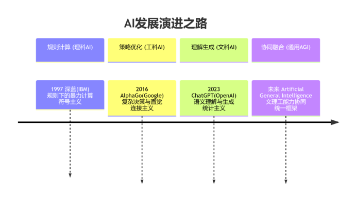





所有评论(0)